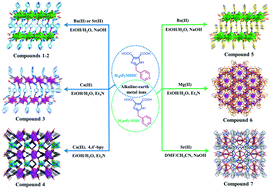A series of alkaline earth metal coordination polymers constructed from two newly designed imidazole-based dicarboxylate ligands containing pyridinylmethyl groups†
Abstract
Two new imidazole-based dicarboxylate ligands, which are 2-(pyridin-4-ylmethyl)-1H-imidazole-4,5-dicarboxylic acid (H3pPyMIDC) and 2-(pyridin-3-ylmethyl)-1H-imidazole-4,5-dicarboxylic acid (H3mPyMIDC), have been designed and successfully synthesized. Both these multidentate ligands are then used to react with different kinds of alkaline earth metal ions under solvothermal conditions, leading to the construction of a series of new coordination polymers (CPs), namely, [Ba(μ5-HpPyMIDC)(H2O)]n (1), [Sr(μ5-HpPyMIDC)(H2O)]n (2), [Ca2(μ4-HpPyMIDC)2(H2O)2]n (3), {[Ca2(μ3-HpPyMIDC)(μ4-HpPyMIDC)(H2O)2]·H2O}n (4), [Ba(μ5-HmPyMIDC)(H2O)]n (5), {[Mg10(μ3-mPyMIDC)3(μ4-mPyMIDC)3(H2O)21]·SO4·12H2O}n (6) and {[Sr(μ2-H2mPyMIDC)2(DMF)2]n·H2O}n (7). Compounds 1 and 2 are isostructural, exhibiting two-dimensional (2D) network structures with a hexagonal honeycomb (6,3) topology if the corresponding metal ions are seen as 3-connected nodes. Compound 3 displays another type of 2D network, which is built by the connection of μ4-HpPyMIDC ligands and Ca(II) centres. Compound 4 is a binodal (3,4)-connected 3D framework with the Schläfli symbol of (6·82)(65·8). The 2D structure of compound 5 is similar to those of compounds 1 and 2, although different kinds of ligands are employed. Compound 6 exhibits an interesting 3D framework with a pcu topology by considering each unusual heptanuclear magnesium cluster as a 6-connected node. In compound 7, connection of μ2-H2mPyMIDC ligands with Sr(II) ions results in the formation of an uncommon 3D chiral framework containing two different types of 1D helical chains. The present results reveal that both these new imidazole-based dicarboxylate ligands containing flexible pyridinylmethyl groups show versatile coordination abilities and are good candidates for fabricating new CPs. Moreover, the thermogravimetric and solid-state luminescence properties of all the compounds have also been studied.



 Please wait while we load your content...
Please wait while we load your content...